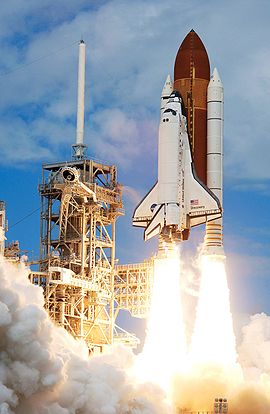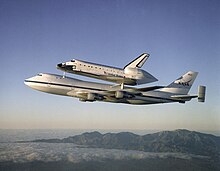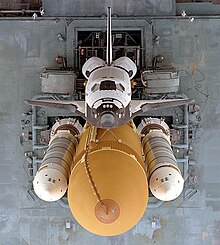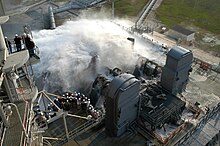"अंतरिक्ष शटल": अवतरणों में अंतर
आशीष भटनागर (वार्ता | योगदान) No edit summary |
आशीष भटनागर (वार्ता | योगदान) |
||
| पंक्ति 63: | पंक्ति 63: | ||
Image:Space Shuttle Endeavour landing.jpg|[[एंडेवर अंतरिक्ष शटल|''एंडेवर'']] टच डाउन पर ब्रेकशूट |
Image:Space Shuttle Endeavour landing.jpg|[[एंडेवर अंतरिक्ष शटल|''एंडेवर'']] टच डाउन पर ब्रेकशूट |
||
</gallery></center> |
</gallery></center> |
||
<gallery> |
|||
Image:Sts mprof.jpg|STS [[Space mission|mission]] profile |
|||
</gallery> |
|||
[[File:Space Shuttle Orbiter-Illustration.jpg|thumb|300px|Space Shuttle orbiter illustration]] |
|||
[[File:Plánik orbitera 2.JPG|thumb|300px|Space Shuttle drawing]] |
|||
[[File:Shuttle Left Wing Cutaway Diagram.jpg|thumb|Space Shuttle wing cutaway]] |
|||
[[Image:Atlantis on Shuttle Carrier Aircraft.jpg|thumb|[[Space Shuttle Atlantis|Space Shuttle ''Atlantis'']] transported by a [[Boeing 747]] [[Shuttle Carrier Aircraft]] (SCA), 1998 (NASA).]] |
|||
[[Image:Space Shuttle Transit.jpg|thumb|[[Space Shuttle Endeavour|Space Shuttle ''Endeavour'']] being transported by a [[Boeing 747]].]] |
|||
[[Image:Space Shuttle vs Soyuz TM - to scale drawing.png|thumb|Space Shuttle Orbiter and [[Soyuz-TM]] (drawn to scale).]] |
|||
[[Image:STS-79 rollout.jpg|right|thumb|An overhead view of ''Atlantis'' as it sits atop the [[Mobile Launcher Platform]] (MLP) before [[STS-79]]. Two Tail Service Masts (TSMs) to either side of the orbiter's tail provide umbilical connections for propellant loading and electrical power.]] |
|||
[[Image:MainSPStest.jpg|thumb|right|[[Water]] is released onto the mobile launcher platform on [[Launch Pad 39A]] at the start of a rare sound suppression system test in 2004. During launch, 300,000 US [[gallon]]s (1,100 m³) are poured onto the pad in only 41 seconds.]] |
|||
[[Image:Space shuttles Atlantis (STS-125) and Endeavour (STS-400) on launch pads.jpg|thumb|200px|upright|Two Space Shuttles sit at launch pads. This particular occasion is due to the final Hubble servicing mission, where the International Space Station is unreachable, necessitating having a Shuttle on standby for a possible rescue mission.]] |
|||
==संदर्भ== |
==संदर्भ== |
||
11:11, 28 दिसम्बर 2009 का अवतरण
 अंतरिक्ष शटल डिस्कवरी लॉन्च | |
| कार्य | मानव सहित आंशिक पुनःप्रयोगनीय लॉन्च एवं पुनर्प्रवेश प्रणाली |
|---|---|
| निर्माता | यूनाइटेड स्पेस एलायंस: en:Thiokol/एलायंट टेक्सिस्टम्स (एस.आर.बी.) लॉकहीड मार्टिन (मार्टिन मैरिएटा) – (ET) रॉकवेल/बोइंग (ऑर्बिटर) |
| मूल देश | |
| आकार | |
| ऊंचाई | 184 ft (56.1 m) |
| व्यास | 28.5 ft (8.69 m) |
| द्रव्यमान | 4,470,000 lb (2,030 t) |
| चरण | 2 |
| क्षमता | |
| LEO को पेलोड | 24,400 kg (53,600 lb) |
| जीटीओ को पेयलोड |
3,810 kg (8,390 lb) |
| लॉन्च इतिहास | |
| वर्तमान स्थिति | सक्रिय |
| लॉन्च स्थल | एलसी-३९, कैनेडि स्पेस सेंटर एसएलसी-६, वैन्डन्बर्ग एएफ़बी (अप्रयुक्त) |
| कुल लॉन्च | १२९ |
| सफल लॉन्च | १२८ |
| असफल परीक्षण | १ (लॉन्च फेल्योर, चैलेंजर) |
| अन्य | १ (री-एन्ट्री फेल्योर, कोलंबिया) |
| प्रथम उड़ान | १२ अप्रैल, १९८१ |
| उल्लेखनीय पेयलोड | ट्रैकिंग एवं डाटा रिले उपग्रह स्पेसलैब ग्रेट ऑब्ज़र्वेट्रीज़ गैलीलियो मैगेलन अंतरिक्ष स्टेशन घटक |
अंतरिक्ष शटल संयुक्त राज्य अमरीका में नासा द्वारा मानव सहित या रहित उपग्रह यातायात प्रणाली को कहा जाता है। यह शटल पुन: प्रयोगनीय यान होता है और इसमें कंप्यूटर डाटा एकत्र करने और संचार के तमाम यंत्र लगे होते हैं।[1] इसमें सवार होकर ही वैज्ञानिक अंतरिक्ष में पहुंचते हैं। अंतरिक्ष यात्रियों के खाने-पीने और यहां तक कि मनोरंजन के साजो-सामान और व्यायाम के उपकरण भी लगे होते हैं। अंतरिक्ष शटल को स्पेस क्राफ्ट भी कहा जाता है, किन्तु ये अंतरिक्ष यान से भिन्न होते हैं। इसे एक रॉकेट के साथ जोड़कर अंतरिक्ष में भेजा जाता है, लेकिन प्रायः यह सामान्य विमानों की तरह धरती पर लौट आता है। इसे अंतरिक्ष कार्यक्रमों के लिए कई बार प्रयोग किया जा सकता है, तभी ये पुनःप्रयोगनीय होता है। इसे ले जाने वाले रॉकेट ही अंतरिक्ष यान होते हैं।

आरंभिक एयरक्राफ्ट एक बार ही प्रयोग हो पाया करते थे। शटल के ऊपर एक विशेष प्रकार की तापरोधी चादर होती है। यह चादर पृथ्वी की कक्षा में उसे घर्षण से पैदा होने वाली ऊष्मा से बचाती है। इसलिए इस चादर को बचाकर रखा जाता है। यदि यह चादर न हो या किसी कारणवश टूट जाए, तो पूरा यान मिनटों में जलकर खाक हो जाता है। चंद्रमा पर कदम रखने वाले अभियान के अलावा, ग्रहों की जानकारी एकत्र करने के लिए जितने भी स्पेसक्राफ्ट भेजे जाते है, वे रोबोट क्राफ्ट होते है।[1] कंप्यूटर और रोबोट के द्वारा धरती से इनका स्वचालित संचालन होता है। चूंकि इन्हें धरती पर वापस लाना कठिन होता है, इसलिए इनका संचालन स्वचालित रखा जाता है। चंद्रमा के अलावा अभी तक अन्य ग्रहों पर भेजे गये शटल इतने लंबे अंतराल के लिये जाते हैं, कि उनके वापस आने की संभावना बहुत कम या नहीं होती है। इस श्रेणी का शटल वॉयेजर १ एवं वॉयेजर २ रहे हैं। स्पेस शटल डिस्कवरी कई वैज्ञानिकों के साथ अंतर्राष्ट्रीय अंतरिक्ष स्टेशन की मरम्मत करने और अध्ययन के लिए अंतरिक्ष में गया था।
दीर्घा
-
STS mission profile













